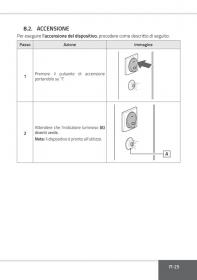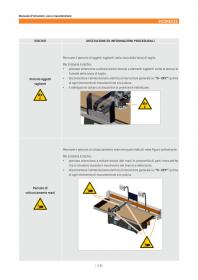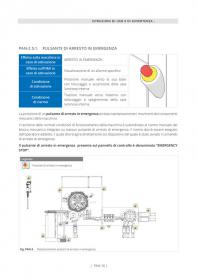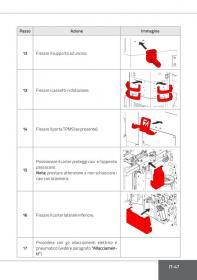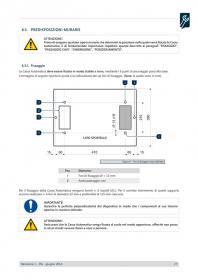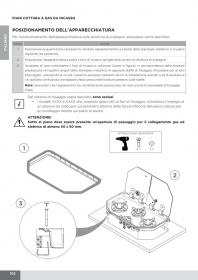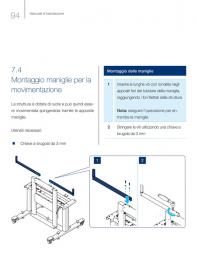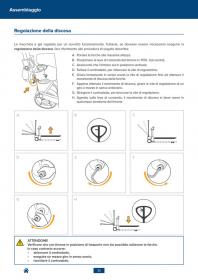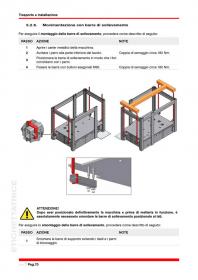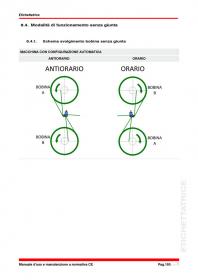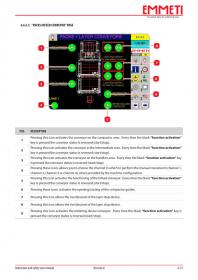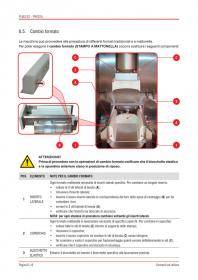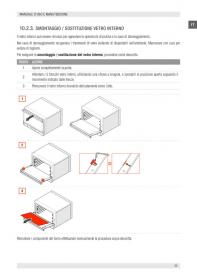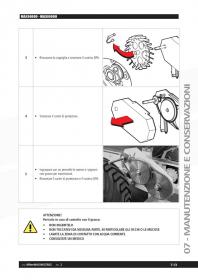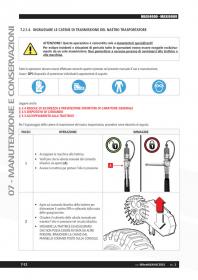Technical manuals differ from each other in specific respects, in particular the target audience and theintended use.
On the contrary, concerning matters of structure, all forms of technical manuals created according to the principles of technical writing share the following attributes: clarity of presentation, conciseness, rapid retrieval of information, and streamlined reference.
Below are the main types of technical manuals that may be of interest to you:
USER AND INSTRUCTION MANUAL
The user and instruction manual is the first safety device of a machine or device, and provides all useful information and instruction for its safe transport, installation, use, adjustment and maintenance.
It is one of the documents contained in the machine's Technical File. As such, it accompanies the machine throughout its entire life cycle, from its commissioning and/or placing on the market until its disposal.
It is an indispensable and legally required document that allows a machine or device to circulate freely in the European Economic Market; it is governed by numerous Directives and Standards (including Machinery Directive 2006/42/EC) that regulate its structure and define its indispensable characteristics and contents.
The information contained in the User and Instruction Manual needs to be divided and treated differently based on the recipient, so that the latter is able to operate the machine in a safe manner.
ATTENTION
The instructions and warnings must not only cover the intended use of the machine, but also cover reasonably foreseeable misuse: i.e., use of the machine in a manner that is not the intended one, as a result of human behaviour that is easily predicted. The instructions should inform the user of possible contraindications associated with the use of the machine that may arise from experience. A machine intended for use by non-professional operators requires that the Instructions for Use be drafted and presented in accordance with the level of general training, and the level of perspicacity that can be reasonably expected.
The manuals we design and draft meet the requirements of all European directives, as they refer to mandatory information that must be incorporated into all manuals.
According to Machinery Directive 2006/42/EC, the user and instruction manual must, for example, include the following information:
- the copy of the EC Declaration of Conformity, or a document containing the contents of the EC Declaration of Conformity
- the drawings, diagrams, descriptions and explanations necessary for the use, maintenance and repair of the machine and for checking its correct operation
- instructions regarding assembly, installation and connection
- a set of instructions for putting into service and using the machine as well as guidelines for training the operator, if necessary
- information about residual risks that remain despite the inherent safety features of the machinery and despite the guards as well as additional protective measures that have been taken
- instructions for safely performing adjustment and maintenance, including the protective measures to be taken during these operations.
Furthermore, the user and instruction manual must be written in the official language(s) of the member state where the machine is placed on the market and/or put into service. The instructions must be in “original” form, and if a translation of the original instructions is provided, a copy of these (for which the manufacturer assumes responsibility) must be attached to the translation.
The main features of the User and Instruction Manual are:
- inclusion of safety information for all the various hazardous stages (based on the Risk Analysis)
- subdivision of chapters and paragraphs customised according to standards and specific customer requirements
- featuring an analysis of styles
- high use of images in order to make the information more understandable
- use of standardised safety symbols
- possibility of writing in a variety of formats (source software or different exports)
NEED FURTHER INFORMATION?
We help you create legally compliant User and instruction manuals, in accordance with the laws imposed by the sector in which your products fall.
INSTALLATION/ASSEMBLY MANUAL
The Installation/assembly manual is a technical document intended for specialised technicians who have to assemble and/or install a machine or system.
This technical manual provides specific information to ensure the correct assembly, installation and commissioning of a machine by an installer/fitter. Furthermore, it highlights risks and safety warnings for technicians.
The main features of the Installation/Assembly Manual are:
- inclusion of safety information for all the various hazardous assembly/installation stages (based on the Risk Analysis)
- high use of images for a better understanding of the various steps
- document that can be included within the User and instruction manualif it is to be provided to personnel dealing with all the steps described in the manual
- document that can be used independently from the User and instruction manual, if it is to be provided to personnel dealing only with the installation/assembly phases.
ASSEMBLY MANUAL
The Assembly Manual is a specific document intended for operators who need to incorporate a partly completed machinery to a machine, or several machines and partly completed machinery to form a system.
Its content is crucial because it contains instructions and warnings necessary for incorporating the partly completed machinery, guaranteeing safety and health protection when carrying out these activities.
The assembly manual should not be confused with the User and Instruction Manual as a partly completed machinery, if not assembled with another machine/plant, cannot be used on its own.
The main features of the Assembly Manual are:
- inclusion of safety information for all the various hazardous assembly stages (based on the Risk Analysis)
- document used to provide information regarding the completion, connection, or coupling of partly completed machinery with another machine or piece of equipment
- inclusion of specific information for the intended use
- it is required by law; it is usually incorporated under the Machinery Directive and must be drawn up as a separate document
DISASSEMBLY MANUAL
The Disassembly Manual is a specific technical manual intended for personnel who have to disassemble the machine and organise the relevant disposal (or recovery) of the various components.
Its content is crucial because it contains the operating procedures for reducing the machine to its first components, allowing the breakdown of different disposals or even reintroducing reusable materials into the circular economy.
Drawing up a Disassembly Manual means moving towards the revolutionary paradigm shift towards circular economy and sustainable models:
- by the EU with the achievement of Climate Neutrality by 2050
- by Italy through the new environmental regulatory framework, which has been expanded with the transposition of the European indications by adopting in September 2020 the 4 new decree-laws (Italian Legislative Decree 116/20 - Italian Legislative Decree 118/20 - Italian Legislative Decree 119/20 - Italian Legislative Decree 121/21) that introduce the basic principles on the preservation of natural resources and end-of-life management of products.
Embracing this paradigm shift requires companies to begin designing new products at the earliest stages of their development, by orienting the design process towards eco-design principles, to be able to think about the product up to the end, to minimise waste, and to anticipate the recovery, recycling and reuse of its components. Rather than thinking of them as waste, they consider them as goods in their own right, with their own economic value, which can be used to recover as many materials as possible as secondary raw materials.
The Disassembly Manual is therefore extremely important because it allows companies to go beyond the usual product design oriented only to the installation, use and maintenance phases, by incorporating an innovative design of the de-construction (decommissioning) phase that allows the following:
- the recovery of most materials
- the reduction of its impact on the environment and natural ecosystems in terms of CO2 Eq. emissions.
The main features of the Disassembly Manual are:
- a document featuring safety information for all the various hazardous assembly stages (based on the Risk Analysis)
- a document vertically oriented to provide procedures for disassembly of the machine/device
- a document with necessary information from LCA (Life Cycle Assessment) and LCC (Life Cycle Costing)
- a document with information for vertical disposal of individual components or recovery methods for various raw materials
The other services related to the Disassembly Manual that we can offer are:
- product eco-design consultancy, both for the Construction and Decommissioning phases
- Life Cycle Assessment (LCA) analysis
- Life Cycle Costing (LCC) analysis
- drafting of the final report and possible EPD (Environmental Product Declaration) certification
- reporting of non-financial information for companies subject to the NFRD (Non-Financial Reporting Directive)
OPERATOR'S MANUAL
The Operator's Manual is a technical manual intended for operators who are in charge of operating the machine (usually) via a graphical interface, or touch screen control panels. In other words, they are operators with a comprehensive understanding of timing, recipes, production, time, and all the parameters required to operate a given machine.
Many times, this manual is written only analytically, describing the individual functions of each screen. Our operator's manual does not stop at this mere illustration of the screens (hardly necessary in the field) but goes so far as to describe the procedures needed to operate the various types of machine operation. Procedures are thus drawn up that describe both the interface commands as well as the manual actions that must be performed in order to achieve the desired outcome.
The main features of the Operator's Manual are:
- inclusion of safety information for all the various hazardous stages of use (based on the Risk Analysis)
- images of the screens with precise references describing the various software fields
- set of instructions describing the sequence of commands and actions necessary to accomplish a particular task
- often the information is ordered in a hierarchical manner and accessible with passwords at different levels
- a document that can be included in the User and Instruction Manual if it needs to be provided to people who are in charge of all the steps described in the manual
- a document that can be used independently from the User and Instruction manual, if it needs to be provided to people who are only in charge of the use of the product.
WORKSHOP MANUAL
The Workshop Manual is a technical guide designed for operators of mechanical workshops (including dealers, distributors, and personnel) requiring specific professional information. This manual caters to individuals performing maintenance, adjustments, cleaning, or other procedures not typically undertaken by end customers, but by service centres, whether internal or external to the manufacturer.
It is a manual primarily comprised of procedures, as it has to meet the mechanic's very specific as well as previously mapped needs. The main features of the Workshop Manual are:
- inclusion of safety information for all the various hazardous stages (based on the Risk Analysis)
- sequence of codified procedures and disconnected from each other
- high use of images for a better understanding of the various steps
- document that takes into account the high specialisation and training of the user for whom it is intended
- document managed separately from the User and Instruction Manual, as the addressee is a professional who only deals with maintenance (and not with use)



